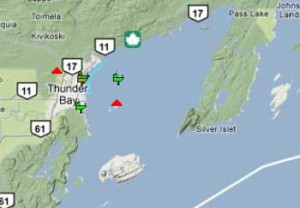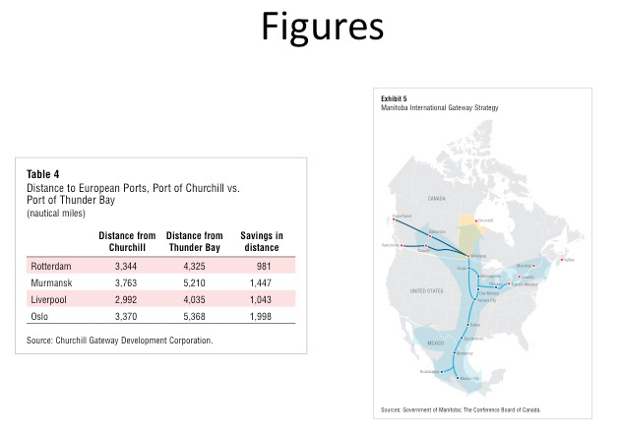 THUNDER BAY – Viewpoint – The new report by the Conference Board of Canada titled Northern Assets: Transportation Infrastructure in Remote Communities on transportation in northern Canada provides a case study of Churchill Manitoba as a potential international gateway that may give the Port of Thunder Bay some cause for concern. The Port of Churchill and its Bay Line rail line play a key role in what is referred to as the Government of Manitoba’s Churchill Gateway System. Churchill could increase its role as a shipping hub by diversifying the range of agricultural products it handles and by increasing its share of Nunavut-bound freight—especially for mining projects. As well, climate change and melting sea ice is opening up the possibility of developing polar shipping lanes between Churchill, Asia, and Europe.
THUNDER BAY – Viewpoint – The new report by the Conference Board of Canada titled Northern Assets: Transportation Infrastructure in Remote Communities on transportation in northern Canada provides a case study of Churchill Manitoba as a potential international gateway that may give the Port of Thunder Bay some cause for concern. The Port of Churchill and its Bay Line rail line play a key role in what is referred to as the Government of Manitoba’s Churchill Gateway System. Churchill could increase its role as a shipping hub by diversifying the range of agricultural products it handles and by increasing its share of Nunavut-bound freight—especially for mining projects. As well, climate change and melting sea ice is opening up the possibility of developing polar shipping lanes between Churchill, Asia, and Europe.
Churchill’s main competitor for Asian and European markets is the Canadian east-west rail-marine transport network and in particular, the Port of Thunder Bay. Table 4 of the Conference Board report shows how Churchill is closer to many European ports than Thunder Bay. The year-round shipping opportunities afforded by global warming apparently makes Churchill an even more attractive shipping venue.
Developing Churchill’s role as a shipping hub in Northern Canada will require substantial investment in transportation infrastructure in and around the community, consolidated effort from public and private stakeholders, and an informed analysis of such a transportation network. A key proponent is the province of Manitoba which has a transport strategy known as Centreport with Winnipeg as a key hub. According to the Conference Board Report:
The overarching aim of the strategy is to “advance Manitoba’s position as a sustainable transportation and distribution gateway of choice for North American mid- continent global commerce and international travel.” The development and growth of the Port of Churchill is a key element of this strategy.
While initial versions of the Centreport Strategy placed Thunder Bay on the eastern arm of the transport network, recent reformulations appear designed to bypass the Port of Thunder Bay entirely. As the accompanying map from the Conference Board report shows, the planned Manitoba International Gateway Strategy now bypasses Thunder Bay completely with the eastern arm being a land route going through Minneapolis and Chicago and then through southern Ontario. The Canadian ports in this strategy are saltwater ports – Prince Rupert, Vancouver, Churchill with the St. Lawrence-Seaway Ports being Detroit-Windsor, Toronto, and Montreal.
However, developing this new North American transportation pattern with Churchill as a northern shipping hub will require substantial new investment in transportation infrastructure. Yet, there is substantial transport infrastructure already in place along the Great-Lakes St. Lawrence Seaway with Thunder Bay’s port already in place with substantial capacity. Why should the Canadian taxpayer be building new transport infrastructure when there is a cost-effective east-west infrastructure already in place that can be incorporated into the Manitoba Centreport and Gateway Strategies?
Alarm bells should be ringing in Thunder Bay given that this new strategy is not just a Manitoba government lobbying strategy but now also seems to have been given the blessing of the Conference Board of Canada. What’s next? A call for Federal government funding to build a rail link from Churchill to the Ring of Fire?
Livio Di Matteo
 Livio Di Matteo is an economist in Thunder Bay, Ontario specializing in public policy, health economics, public finance and economic history. Livio Di Matteo is a graduate of the Fort William Collegiate Institute (1898-2005) whose school motto “Agimus Meliora” has served as a personal inspiration. Livio Di Matteo holds a PhD from McMaster University, an MA from the University of Western Ontario and an Honours BA from Lakehead University. He is Professor of Economics at Lakehead University where he has served since 1990. His research has explored the sustainability of provincial government health spending, historical wealth and asset holding and economic performance and institutions in Northwestern Ontario and the central North American economic region. His historical wealth research using census-linked probate records is funded by grants from the Social Sciences and Humanities Research Council of Canada. He has constructed, assembled and analyzed nearly 12,000 estate files for Ontario over the period 1870 to 1930. Livio Di Matteo writes and comments on public policy and his articles have appeared in the National Post, Toronto Star, the Winnipeg Free Press and Thunder Bay Chronicle-Journal and NetNewsledger.com. Livio Di Matteo has had an entry in Canadian Who’s Who since 1995.
Livio Di Matteo is an economist in Thunder Bay, Ontario specializing in public policy, health economics, public finance and economic history. Livio Di Matteo is a graduate of the Fort William Collegiate Institute (1898-2005) whose school motto “Agimus Meliora” has served as a personal inspiration. Livio Di Matteo holds a PhD from McMaster University, an MA from the University of Western Ontario and an Honours BA from Lakehead University. He is Professor of Economics at Lakehead University where he has served since 1990. His research has explored the sustainability of provincial government health spending, historical wealth and asset holding and economic performance and institutions in Northwestern Ontario and the central North American economic region. His historical wealth research using census-linked probate records is funded by grants from the Social Sciences and Humanities Research Council of Canada. He has constructed, assembled and analyzed nearly 12,000 estate files for Ontario over the period 1870 to 1930. Livio Di Matteo writes and comments on public policy and his articles have appeared in the National Post, Toronto Star, the Winnipeg Free Press and Thunder Bay Chronicle-Journal and NetNewsledger.com. Livio Di Matteo has had an entry in Canadian Who’s Who since 1995.
This article was originally posted on Livio Di Matteo’s NORTHERN ECONOMIST Blog at http://ldimatte.shawwebspace.ca.

